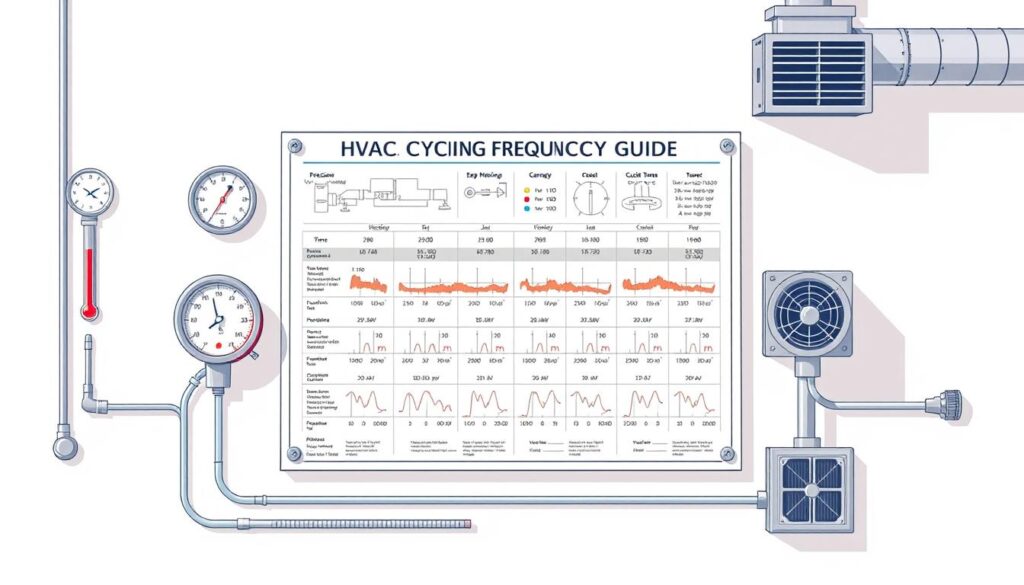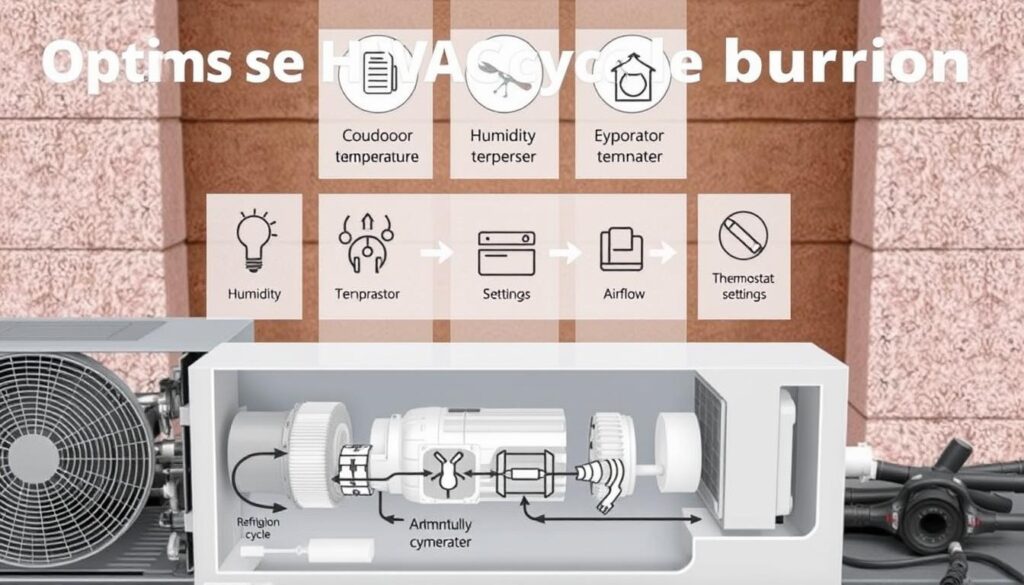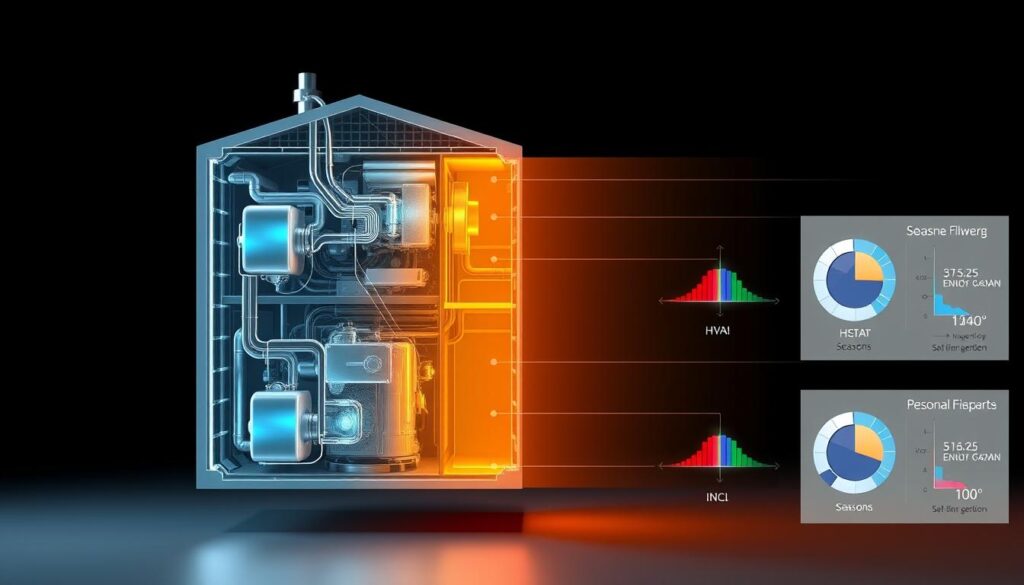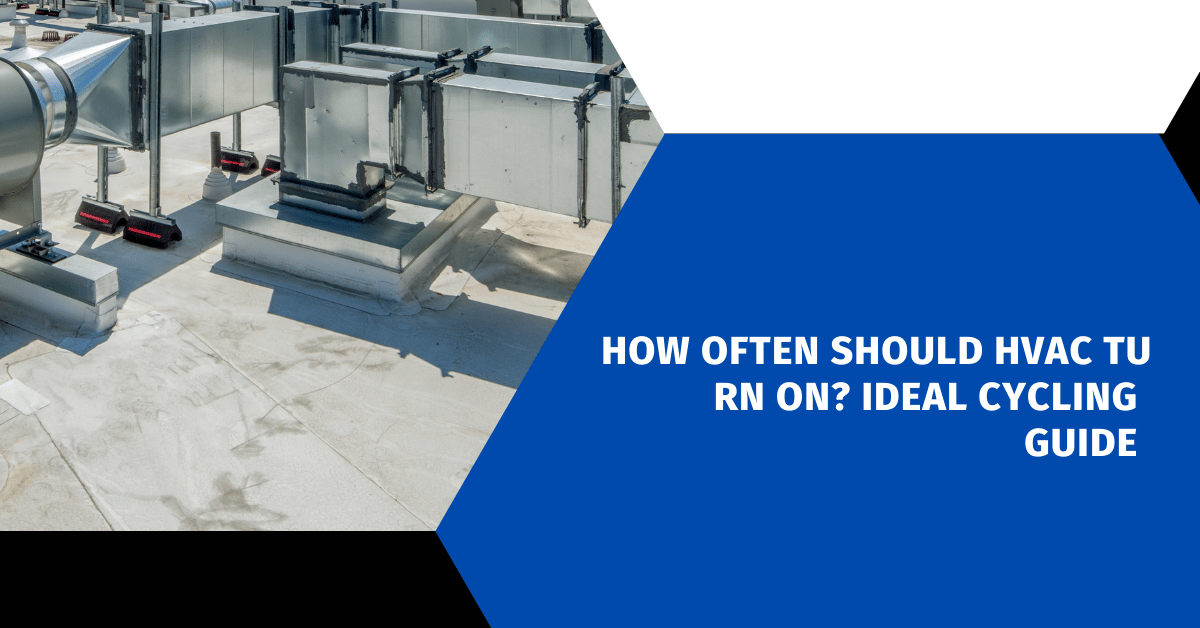Affiliate Disclosure
HVAC Guide Guys is a participant in the Amazon Services LLC Associates Program, an affiliate advertising program designed to provide a means for sites to earn advertising fees by advertising and linking to Amazon.
How Often Should HVAC Turn On? Knowing when your HVAC system should turn on is key for comfort and saving energy. An HVAC cycle is the time your heating or cooling unit runs to keep your home at the right temperature. Finding the best cycle time helps your system work better and save you money.

Your home’s comfort relies on keeping the temperature just right. Today’s HVAC systems turn on and off to keep your home cozy while using less energy. If you know how your system cycles, you can make it work better and last longer.
Getting your HVAC to cycle right means finding a balance between comfort and energy use. Things like the weather outside, how well your home is insulated, and your thermostat settings all affect how often your system should run.
Key Takeaways
- HVAC cycling frequency impacts home comfort and energy efficiency
- Optimal system operation varies based on environmental conditions
- Understanding cycling patterns helps prevent unnecessary wear
- Thermostat settings significantly influence HVAC performance
- Regular maintenance ensures consistent system cycling
Table of Contents
Understanding HVAC Cycling Basics
Your home’s comfort depends on knowing how HVAC systems work. HVAC cycling times are key to keeping the right temperature. They help your system work best in your home.
An HVAC system doesn’t run all the time. It goes through certain cycles. These cycles help your system control indoor temperatures and keep you comfortable.
What Defines a Complete HVAC Cycle
A complete HVAC cycle has a few main parts:
- System startup
- Cooling or heating phase
- Temperature stabilization
- System shutdown
Normal Operating Patterns
Most HVAC systems cycle every 15-20 minutes. In this time, your system does a few things:
- Draws in ambient air
- Processes temperature changes
- Distributes conditioned air
Impact on Home Comfort
Good HVAC cycling makes your home more comfortable. Consistent cycling keeps temperatures steady. It also controls humidity and spreads air evenly.
Knowing about these cycles helps you make your system work better. This makes your home a more comfortable place to be.
Explore Our HVAC Shop
Looking for top-rated HVAC tools, parts, and accessories? Visit our shop and find the perfect solution for your needs.
Visit the ShopOptimal HVAC Cycling Frequency
Knowing the right hvac runtime is key for home comfort and system efficiency. Your air conditioning should aim for 2-3 cycles per hour. This keeps your home at a steady temperature.
The best cycling frequency depends on several factors:
- Outdoor temperature
- Home insulation quality
- HVAC system efficiency
- Home square footage
A good HVAC system runs for 15-20 minutes in each cycle. Short cycling or long runs might mean system issues. These could need a pro to check.
Different places have different needs for cycling. Homes in humid areas might need more cycles than dry ones. Your home’s specifics are important for finding the best cycle pattern.
Pro tip: Regular maintenance helps keep hvac cycles optimal and avoids system overload.
Watch how your system works. If it cycles consistently and moderately, it’s likely healthy. This means it keeps your home comfy while saving energy.
How Often Should HVAC Turn On: Standard Guidelines
Knowing when your AC should turn on is key to a comfy home and saving energy. The frequency of your HVAC system’s cycles changes based on the season, temperature, and your home’s layout.
Following standard guidelines for AC runtime helps your system work better and saves energy. This is good for both your wallet and the planet.
Peak Season Operation
In very hot weather, your AC might cycle more often to keep your home cool. Here’s what you can expect during the hottest months:
- 15-20 minute cooling cycles
- 2-3 cycles per hour during hottest periods
- Potential continuous operation during extreme heat waves
Off-Peak Performance
When it’s not as hot, your HVAC system cycles less. Here’s what happens in milder weather:
- 10-15 minute cooling cycles
- 1-2 cycles per hour
- Reduced overall runtime
Nighttime vs Daytime Cycling
Day and night, your AC cycles differently because of temperature changes and cooling needs:
| Time of Day | Typical Cycle Duration | Frequency |
|---|---|---|
| Daytime | 15-20 minutes | 2-3 cycles/hour |
| Nighttime | 10-15 minutes | 1-2 cycles/hour |
Pro tip: Keep an eye on your system and get it checked by pros to make it cycle better.
Explore Our HVAC Shop
Looking for top-rated HVAC tools, parts, and accessories? Visit our shop and find the perfect solution for your needs.
Visit the ShopSigns of Healthy HVAC Cycling
It’s important to keep an eye on how often your HVAC system cycles. A good system keeps your home at a comfortable temperature. It does this by cycling on and off in a predictable way.
Knowing when your HVAC system is working right is key. A healthy system will:
- Finish full cooling or heating cycles in 10-15 minutes
- Turn on 3-4 times an hour when it’s really hot or cold
- Keep the indoor temperature close to what you set it to, within 1-2 degrees
Look out for these signs that your HVAC is cycling well:
- Steady Temperature Control: Your home stays at a comfy temperature without big changes
- Balanced Humidity Levels: Your indoor air isn’t too wet or too dry
- Quiet Operation: The system makes little noise when it starts and stops
But, if your system cycles too much or too little, it might be a problem. If your HVAC system doesn’t follow these patterns, it’s time to call a pro. They can check it out and make sure it keeps working well.
Common Cycling Problems and Solutions
Many issues can affect how often your HVAC system turns on. Knowing these problems helps keep your system running right. It also stops long-term damage.
Homeowners face three main cycling challenges. These need careful attention:
Short Cycling Dilemmas
Short cycling means your HVAC system turns on and off fast, usually in 10 minutes. This can stress your system and lower efficiency. Common causes include:
- Dirty air filters blocking airflow
- Oversized HVAC equipment
- Refrigerant level imbalances
- Faulty thermostat readings
Extended Run Time Challenges
When your HVAC system runs non-stop, it shows a problem. Long operation raises energy use and wears down the system. Common reasons are:
- Inadequate insulation
- Blocked air vents
- Malfunctioning compressor
- Incorrect thermostat calibration
Emergency Shutdown Patterns
Unexpected shutdowns mean serious issues need a pro. These problems might be electrical, overheating, or component failures.
“Proactive maintenance prevents unexpected HVAC breakdowns and ensures consistent home comfort.” – HVAC Expert
If you keep having cycling problems, get a pro. They can find and fix complex issues with your HVAC system.
Explore Our HVAC Shop
Looking for top-rated HVAC tools, parts, and accessories? Visit our shop and find the perfect solution for your needs.
Visit the ShopFactors Affecting HVAC Cycle Duration

Knowing what affects hvac cycling times is key for better system performance. Your home’s heating and cooling system is not alone. Many things influence how long and often it runs.
Temperature is a big player in how well your HVAC system works. Outdoor weather greatly impacts cycle time. Extreme temperatures make your system work harder and longer.
- Outdoor temperature
- Indoor heat load
- System capacity
- Home insulation quality
- Thermostat settings
Many environmental and structural factors can change your HVAC’s cycle patterns. Poorly insulated homes will have more frequent and longer cycles. This is different from well-insulated homes.
| Factor | Impact on Cycle Duration |
|---|---|
| Outdoor Temperature | Directly increases cycle length during extreme weather |
| Home Insulation | Reduces cycle frequency by maintaining consistent temperatures |
| System Size | Oversized/undersized systems disrupt optimal cycling |
By knowing these factors, you can make better choices for your HVAC system. This can help improve its efficiency and lifespan.
Impact of Thermostat Settings on Cycling
Your HVAC system’s performance depends a lot on thermostat settings. Knowing how these settings affect hvac runtime and cycles can help you save energy and stay comfortable.
Thermostat settings are key to managing your home’s temperature. They also affect your HVAC system’s performance. Changing these settings can make your system turn on and off more or less often.
Programming for Efficiency
Smart programming can cut down energy use and boost system performance. Here are some tips:
- Set slightly higher temperatures during summer
- Use programmable schedules for different times of day
- Implement zonal temperature controls
Temperature Differential Settings
The gap between your set temperature and when the system kicks in affects cycling. A smaller gap means more cycles, while a bigger gap reduces strain.
| Differential Range | Cycling Frequency | Energy Impact |
|---|---|---|
| 1-2 degrees | High | Increased energy use |
| 3-4 degrees | Moderate | Balanced performance |
| 5-6 degrees | Low | Energy efficient |
Smart Thermostat Benefits
Modern smart thermostats have cool features to improve hvac runtime. They learn your habits, adjust automatically, and show detailed energy use.
- Machine learning temperature optimization
- Remote control via smartphone
- Detailed energy usage reports
Explore Our HVAC Shop
Looking for top-rated HVAC tools, parts, and accessories? Visit our shop and find the perfect solution for your needs.
Visit the ShopSeasonal Variations in HVAC Cycling

Your home’s air conditioning system changes a lot with the seasons. In summer, it works extra hard to keep your home cool. This means it runs longer and more often.
Knowing how long your AC should run helps you get the most out of it. Summer is the toughest time for your AC, with it running for hours in really hot weather.
- Summer: Longest AC runtime, multiple cooling cycles
- Spring/Fall: Moderate cycling patterns
- Winter: Minimal cooling requirements
Changes in temperature affect how your AC works. In very hot summers, it might run non-stop for hours. But in cooler seasons, it runs shorter and less often.
To keep your HVAC system running well, be prepared for the seasons. Here are some tips:
- Schedule professional maintenance before peak seasons
- Clean or replace air filters regularly
- Use programmable thermostats for efficient cycling
- Ensure proper home insulation
By taking care of your HVAC system, you can save energy and make it last longer, no matter the season.
Maintaining Proper Cycling Through Regular Service
Keeping your HVAC system in top shape is key. Regular maintenance helps manage how often your furnace cycles and keeps your HVAC running efficiently. A well-planned maintenance routine can stop problems before they start and make your system work better.
Here’s what you should do regularly:
- Clean or replace air filters every 1-3 months
- Check refrigerant levels annually
- Inspect electrical connections
- Clean condenser and evaporator coils
- Lubricate moving parts
Experts say you should get a full service twice a year. Once before summer and once before winter. These checks catch early signs of trouble that could mess with your HVAC’s cycle.
| Maintenance Task | Frequency | Benefits |
|---|---|---|
| Air Filter Replacement | Every 1-3 months | Improved air quality, reduced strain on system |
| Professional Inspection | Biannually | Early problem detection, optimal cycling |
| Refrigerant Check | Annually | Maintains efficient HVAC usage |
Regular maintenance pays off in many ways. It makes your HVAC last longer, uses less energy, and saves you from big repair bills. Prevention is always more cost-effective than reactive repairs.
Explore Our HVAC Shop
Looking for top-rated HVAC tools, parts, and accessories? Visit our shop and find the perfect solution for your needs.
Visit the ShopEnergy Efficiency and Cycle Optimization
Knowing when your HVAC system should turn on is key to saving energy and cutting costs. The frequency of your HVAC system affects your home’s comfort and your monthly bills.
Improving how often your HVAC cycles can save you money and make your system work better. Here are some ways to boost energy efficiency:
Cost-Saving Strategies
- Use a programmable thermostat
- Set temperatures that don’t overwork your system
- Turn off your HVAC when the weather is mild
Peak Load Management
When it’s hot or cold, your HVAC uses a lot of energy. Smart management can cut down on energy use:
- Change your thermostat during the most expensive hours
- Use ceiling fans to spread out the cool air
- Do less heating or cooling when it’s expensive
Energy Consumption Patterns
Watching how often your HVAC runs can teach you a lot. Longer AC cycles mean fewer restarts. This can:
- Make your system last longer
- Use less energy overall
- Save you money on repairs
By figuring out the best time for your HVAC to turn on, you can make your home more energy-efficient. This will also help keep your utility bills low.
Conclusion
Knowing about hvac cycling times is key to a comfy and efficient home. Your HVAC system’s work affects your comfort, energy use, and equipment health. By focusing on the best ways to use your HVAC, you can lessen the wear and tear on it.
Keeping an eye on how often your system runs helps avoid big problems. Look for steady run times, the right temperatures, and smooth changes between heat and cool. Taking care of your system early can save you money and make it last longer.
This guide gives you a clear plan for handling your home’s climate control. It’s useful for dealing with changing seasons or wanting to use less energy. By understanding how your HVAC works, you can make your home more comfortable and save money.
Watch your system closely, ask for help from HVAC experts when you need it, and remember that knowing is power. Your home will be more comfortable, and you’ll spend less on energy with the right HVAC management.

